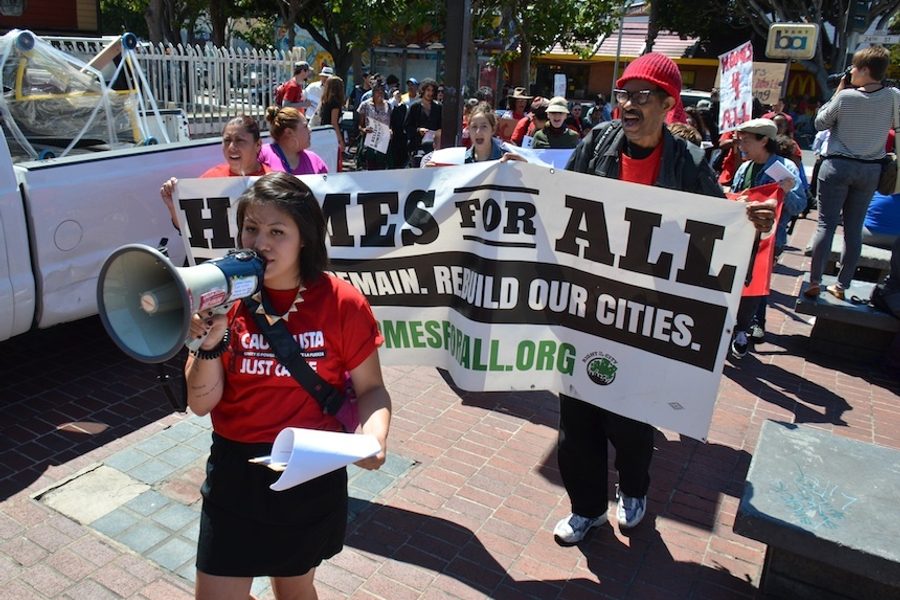How To Curb Gentrification
A new report from California housing advocates and racial justice organizers lays out a blueprint.
Julia Wong

In 2011, Mustafa Solomon, a 57-year old African-American photographer, was served eviction papers. He’d lived in the same apartment in North Oakland for more than 15 years. Now, following what Solomon calls a “small, accidental fire in the kitchen,” his landlord wanted him out.
Solomon believes his landlord had another motive: The unit he shared with his adult daughter and pet dog cost $530 a month, but rents in his neighborhood had been rising quickly due to gentrification. “If I was moving in now, this apartment would probably be $950-1,200 per month,” Solomon says. “They were hoping I would go away and not come back so they could get someone else in here.”
Unwilling to go quietly, Solomon appealed the eviction to Oakland’s Rent Board, the city agency tasked with mediating disputes between landlords and tenants. According to Solomon, the hearing officer decreed that the eviction did not meet the requirements of Oakland’s “Just Cause” eviction ordinance, a law that limits a landlord’s ability to evict to a discrete number of reasons, such as failure to pay rent or a material violation of a tenant’s lease. Solomon and his daughter would have to leave the apartment temporarily, so the landlord could complete repairs, but they would be allowed to move back in.
Solomon and his daughter vacated the apartment in June 2013. The repairs were estimated to take just two months, but stretched to six. Without any relocation assistance, the only housing they were able to find was in Vallejo, 25 miles away. The cost of moving, combined with the longer commute, placed severe financial stress on the family. “Everything that I had put away for retirement was used up,” he says. “Now I’m back to nothing.”
In researching the history of the “Just Cause” ordinance, Solomon discovered that Causa Justa :: Just Cause (CJJC), a Bay Area tenants’ rights and racial justice organization, had campaigned to pass the law in 2002. Today, Solomon is a CJJC member: “I’m a tenants’ rights activist now. I don’t want this to ever happen to anyone else,” he says.
But Solomon is one of the lucky ones. According to an April report by CJJC, “Development Without Displacement” — the result of CJJC’s collaboration with Alameda County to study the effects of gentrification in Oakland and San Francisco — the neighborhood of North Oakland is in a late stage of gentrification. Median rents in the formerly affordable neighborhood are now higher than those in historically affluent neighborhoods of Oakland and African-American homeownership has dropped from 50 percent to 25 percent. The African-American population of Oakland overall has dropped nearly 40 percent since 1990.
Across the Bay, San Francisco is experiencing a similar demographic shift. Median monthly rents in the most gentrified neighborhoods rose 40 percent between 1990 and 2011. Working-class communities and communities of color are being pushed out and the two cities are becoming whiter and richer. The black population has halved, falling from 10 percent to just 5 percent of the overall population. The number of Latino households in the historically Latino Mission District has decreased by 1,400, while the number of white households has shot up.
While much of the discourse around gentrification has relied on qualitative descriptions of changes in neighborhoods — the appearance of new restaurants and shops, cultural differences between new and old residents — the CJJC report applies a quantitative methodology to the study of neighborhood change. By analyzing demographic, socioeconomic and property data at the census tract level, CJJC determined how much “gentrification-related change” had occurred in historically divested neighborhoods over two decades, and then classified each tract as belonging to one of seven stages of gentrification.
The report found that aside from changing demographics, gentrification and displacement are also damaging public health. Across the Bay Area’s two biggest cities, black residents already experience the highest mortality rates of any group. But CJJC found that the disparity between black and white mortality rates increases as gentrification evolves into its later stages. CJJC argues that the indirect impacts displacement often has on communities — from financial distress, overcrowding and substandard housing conditions to the weakening of community support networks — can damage individuals’ mental and physical health.
According to Robbie Clark, CJJC’s lead housing rights campaign organizer, the study grew out of the group’s observation that gentrification was the result of “collusion between government and private capital.”
“For years we’ve had the analysis that the main driver behind the Bay Area housing crisis was the way that neoliberal politics drives displacement of working-class black and Latino communities,” Clark says.
The report bore out CJJC’S observations of the racialized nature of displacement. Findings show working class communities of color in the two cities have fallen victim to a vicious cycle of disinvestment, followed by displacement. Private and public sources of investment (i.e. real estate developers or public funds for infrastructure work) have tended to follow white populations while avoiding the neighborhoods where people of color live. This leads to lower property values in neighborhoods of color. In periods of gentrification, the abundance of cheap real estate in these same areas becomes attractive to private investors hoping to buy low and sell high (“flipping” in real estate parlance), or raise rent on the property by replacing the old residents with new (possibly richer) tenants who don’t qualify for rent control. The results of the process are higher rents and rampant evictions of longtime residents.
Following long periods of disinvestment by cities, a major influx of funds — such as subsidies for a transit-oriented development — can also exacerbate displacement, the report asserts. Transit-oriented developments prioritize building around public transit centers and have gained popularity as greener alternative to auto-centered city planning. However, the report cites research suggesting that public transit investment can displace transit-dependent residents while attracting people who own cars, eventually pricing out those who stood to benefit from improved public transit.
Crucially, CJJC’s analysis busts the biggest “development” myth: Gentrification is not inevitable — it can be prevented before it starts and stopped in neighborhoods where the process is already underway. The report proposes a comprehensive policy agenda to mitigate the effects of ongoing gentrification and prevent further displacement.
“Since the government has taken such a key role in creating gentrification,” Clark says, “it can also help fight it.” The proposals envision a “move away from overreliance on the private market to meet the housing needs of our communities.” The group hopes to put an initiative on the ballot in Oakland that would ban the kind of harassment techniques landlords use when they’re trying to evict tenants, including refusing to perform maintenance or threatening to report undocumented tenants to Immigration and Customs Enforcement.
CJJC is also part of a coalition pushing for an anti-speculation tax in San Francisco, which would impose a windfall profits tax on real-estate speculators who buy and sell properties without keeping the building for six years or more. The tax rate decreases each year and is designed to disincentivize the real estate “flipping” — buying low and selling high — that contributes to displacement in gentrifying neighborhoods.
“It takes a combination of policy and community organizing,” Clark says. “The report has policies that will help stem the tide of displacement, but there also needs to be a shift in the way planning decisions get made. City governments need to start seeing the people who live in these neighborhoods as stakeholders who should have a say.”
Mustafa Solomon is ready to be part of that movement. “It’s a human rights issue for people to have a place to live,” he says. “A lot of people don’t know what to do. But the most important thing to remember is that there are more tenants than landlords, so if we stick together, we can win this.”







